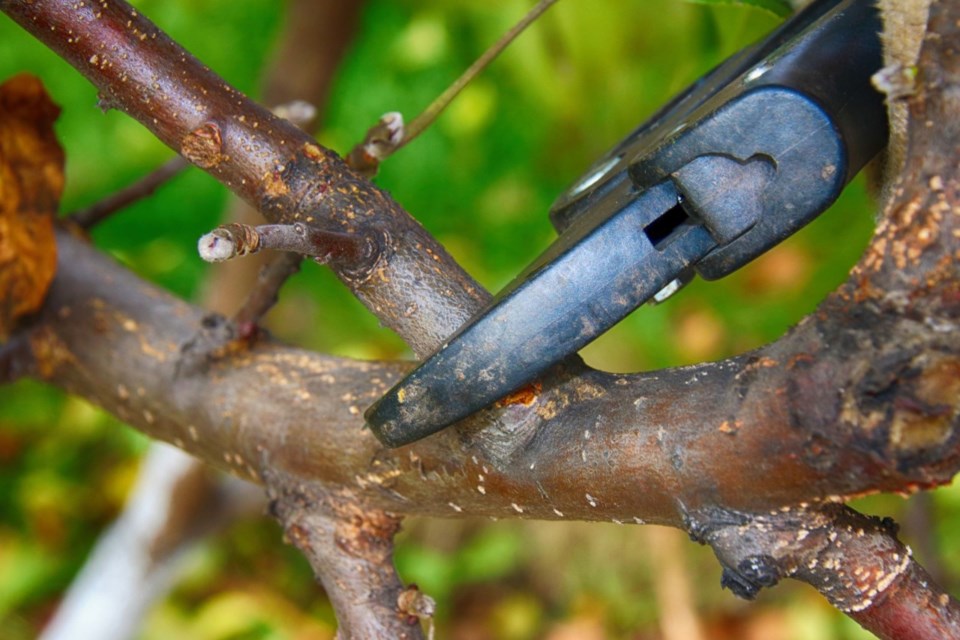The following column was submitted to the Tri-City News from Brian Minter — master gardener, best-selling author, Order of Canada recipient and co-owner of .
You really don't have to be an expert to prune fruit trees.
All it takes is a little common sense and a few helpful hints.
As a rule of thumb, I place fruit trees in three different pruning categories: the 'open centre,' the 'central leader' and the 'espalier' form.
Apples, pears and plums should have their centres opened up to allow more sun and air to flow through.
This technique is called 'open-vase' pruning, and it allows fruit to develop on the inside of the tree, on the tips and on the outward-growing branches.
For this type of pruning, simply choose to retain three to five dominate branches radiating out from the main stem.
These branches should be five or six feet off the ground, allowing you to comfortably walk or work under the tree without hitting your head.
Once you have determined which branches you are going to keep, cut out any other branches left in the centre, as well as any inward-growing ones.
Next, cut out many of the upward-growing branches (so-called sucker growth), leaving the tree looking like a 'Y.' The remaining branches should be pruned back each year at two-foot intervals, keeping this 'Y' formation intact.
A heavy pruning each year, unfortunately, results in a mass of water sprouts shooting out in all directions.
To minimize this problem, once you have developed the tree's 'open-vase' shape, you should switch to a training program rather than a pruning program.
Training simply means weighing down the branches with soil-filled plastic bags to encourage growth in a horizontal pattern.
This technique will minimize the need for massive pruning and greatly reduce the number of water sprouts you have to deal with each year.
You will also find that these horizontal branches will be your best fruit-bearing stems.
You will still have to cut them back at 18- to 24-inch intervals to keep the tree's size in check, but this type of pruning will result in a tree that is far more productive and much easier to maintain.
Sweet cherries present a slightly different problem.
They are, perhaps, the most vigorous of all fruit trees and resist any attempt to be pruned in an 'open-vase' shape. Sweet cherries tend to have a very strong stem or leader, and because of that, they require 'central leader' pruning.
'Central leader' pruning simply means cutting back the main stem each year to control the rate of growth and at the same time, cutting back the outward-growing branches even further, leaving an overall pyramidal form.
If there are two or three strong central stems, it may be a good idea to eliminate all but one to avoid competition and to thin out the tree.
The outward-growing branches should be pruned back at a 45-degree angle.
Next season the central leader may develop two or three new branches. The one that grows into the strongest and most upright main stem should be treated as your central leader, and the other remaining stems can be removed or left, depending upon their growth habit.
If they can be trained in an outward direction, simply cut them back next year on a 45-degree angle along with the other branches.
Try, however, not to let the centre of the tree become cluttered.
If you maintain the outside branches at a 45 degree angle each year, the result will be a tree which is fairly open and easy to maintain, and one which will stay within reach of your ladder.
Some of the best cherry trees for a smaller home garden are the new dwarf varieties on a Giesla root stock. Self-fertile varieties, like ‘Stella,' 'Lapin’ and ‘Sweetheart’, are among the best.
Espalier pruning is primarily done on trees such as peaches, nectarines and apricots.
To minimizes disease problems, such as 'peach leaf curl', these trees should be grown against the south or west side of a building to maximize sun exposure and minimize rain on the branches and leaves.
Very compact apple and pear varieties can be grown in the same manner, except out in the open against a fence or other support device. All that is necessary here is the removal of frontward- and backward-growing branches which don't conform to an espalier formation.
The most common problem is leaving too many branches on the tree, which causes over-production and simply clutters up the tree.
Choose three to five sets of the strongest sideward-growing branches and remove the rest.
If these branches tend to grow upward, use a long bamboo pole as a T-bar to hold the branches in place. You will have to be quite ruthless in your pruning to maintain this very strict form. Most branches radiating off this framework will have to be removed, leaving many spurs and fruit buds along each stem.
You will probably run into a hundred questions once you start pruning. Many good, easy-to-understand books are available.
Good pruning books will have excellent diagrams showing how your tree should look after each progressive season, and as you know, pictures are worth a thousand words. Online pruning resources are available. For example, have great videos on how to prune fruit trees.
Pruning fruit trees is actually a lot of fun. You will learn a little more from each pruning session and in just a few years, you will quickly develop a real sense of how it is done.
Most garden stores offer pruning seminars at this time of year, and I find them most helpful and informative.

